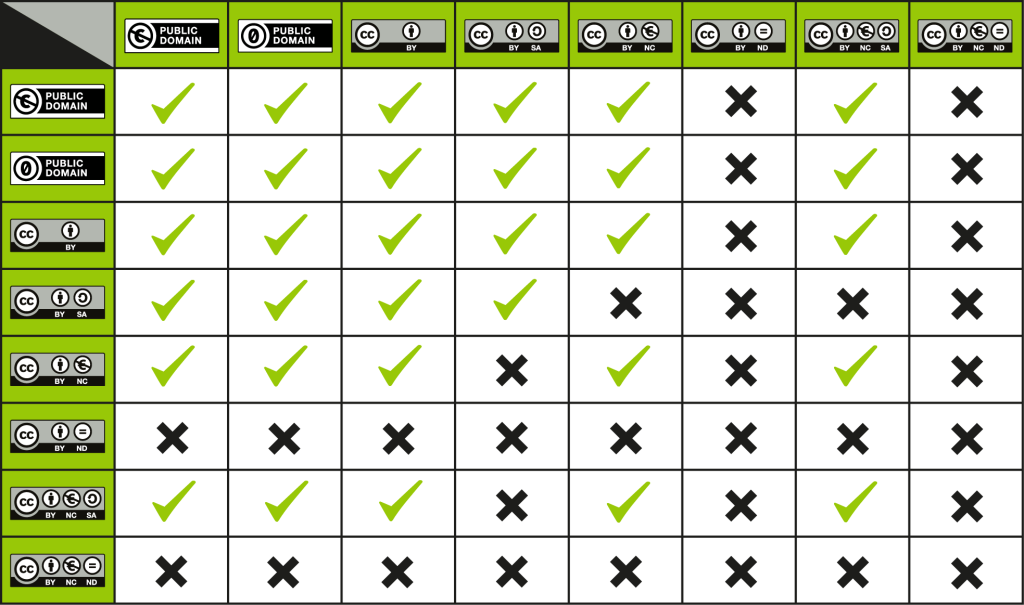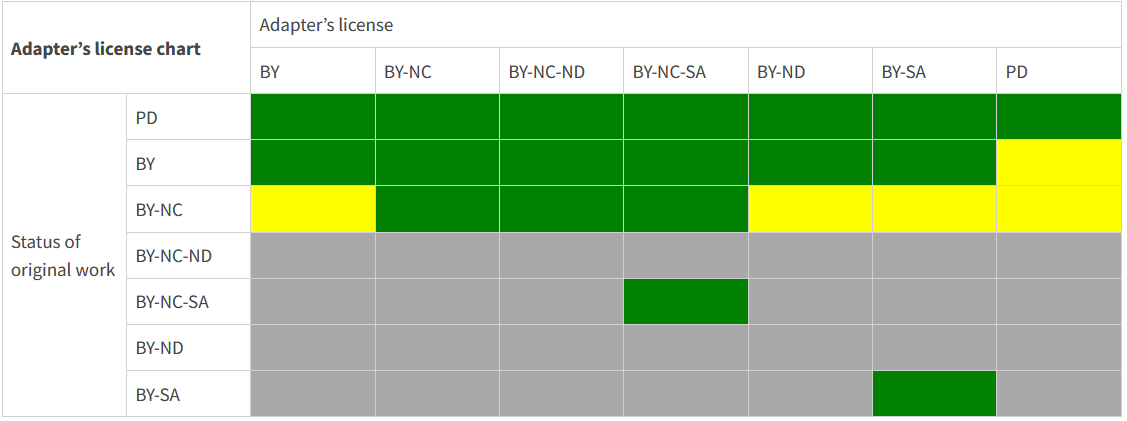6
Arianna Cheveldave
One of the most appealing aspects of the Creative Commons licences is that many of them permit adaptations. As opposed to just being available for free, many CC-licensed works encourage you to make changes to them for your own purposes.
We talked about how to select a licence for your original open work in Anatomy of a CC Licence, but licensing an adapted work can be more complicated. One of the trickiest parts is figuring out if your work is a collection or an adaptation.
Collections
A collection is a grouping together of discrete works into one work such that each component work is distinguishable from one another. Examples of collections include:
- An anthology of short stories
- A series of photos
- A music album
- A book of sheet music containing a dozen pieces
Licensing Considerations
If you selected 15 openly licensed songs, downloaded the audio files for them, arranged them in a particular order in one big file, then released this file to the world, you would have a collection that you could openly license. This licence would apply to the particular order of the songs, and if you released physical versions of the album as CDs and designed original cover art for the CD cases, you could also license the cover art. But you would not own the copyright to or be able to change the licence for any of the individual songs on the CD: the original Creative Commons licence applied to each song would still be in effect, and the copyright would still belong to the licensor. You would also need to comply with the terms of each song’s licence and provide attribution for each copyright owner.
All Creative Commons licences permit works to be incorporated into collections. That’s right: because a collection does not count as a derivative work, you may even include in your collection a work carrying a CC BY-ND or CC BY-NC-ND licence. The NoDerivatives element of the licence means that modified versions of the work may not be shared, but reproducing the work in whole is completely legal, so you may add an ND work to a collection.
Collection Example
I created a collection called All You Need to Know about Writing, an open text that contains chapters from several different open textbooks. The copyright statement on the home page says:
All You Need to Know about Writing by Arianna Cheveldave is licensed under a CC BY 4.0 licence, except where otherwise noted. It contains content from other openly licensed works, whose authors are clearly indicated in the applicable chapters.
At the beginning of each chapter is a statement like the following:
“Expository Essays” by Tara Horkoff is licensed under a Creative Commons Attribution-NonCommercial-ShareAlike 4.0 International licence (CC BY-NC-SA 4.0). It was originally published in Writing for Success – 1st Canadian H5P Edition.
Each chapter is imported from another open textbook in Pressbooks. This platform makes it very easy to import open content as well as licensing information from other books. If you look at the beginning of any chapter, you’ll see that the chapter author is named directly below the chapter title. At the end of each chapter is a copyright statement that indicates the chapter’s specific licence.
For more information about how to import a web page or Pressbooks webbook to your own Pressbooks webbook, see the Pressbooks Guide by BCcampus.
Adaptations
An adaptation (also called a remix, adapted work, or derivative work) is a work that is based on another work but has had sufficient original thought and creativity put into it that it qualifies as a separate work. Unlike in a collection, the component parts of an adaptation are blended together such that you cannot tell where a component from one work ends and another begins.
You are probably familiar with the concept of a film adaptation of a book. In such a case, whoever owns the right to adapt the book for film (probably either the author or the publisher) has sold or licensed that right to a movie studio or producer. For works with closed copyrights, you usually cannot adapt the work without licensing or purchasing this right.
Examples of how you might adapt a work include:
- Translating a work
- Adapting the work for a different medium, such as book to film or film to play
- Modifying the work by adding or removing content
Licensing Considerations
Of the six Creative Commons licences, four permit anyone to adapt a work and share their adaptation with anyone. (For more information about the two licences that don’t allow this, see ND in Anatomy of a CC Licence.) If you are thinking about adapting an openly licensed work, first check the terms of the licence. Are you permitted to share adaptations of this work? Do you want to share adaptations of this work, or do you just want to adapt a copy for your own private use?
Once you have cleared the first hurdle of understanding the terms of the open licence attached to the original work, you may embark on the task of adapting the work. For some, doing the actual adapting might look like the easy part, compared to figuring out what licence to apply once the work is done!
Licence Compatibility
When you’re adapting a work, you may choose to make changes to one single work and add your original contributions to it. However, you may also choose to combine elements from two or more different works, plus or minus your own contributions. This scenario is more complicated than adapting a single work, as you have to consider licence compatibility and what licence you are allowed to apply as an adapter.
The Creative Commons FAQ “Can I combine material under different Creative Commons licenses in my work?” covers this issue in detail. It contains a handy chart for understanding what licences are compatible when remixing works, seen below:

To determine if two works may be mixed together, look for the licence of the first work on the left-hand side of the chart. Then, find the second work in the top row of the chart. Look at where the two licences intersect on the chart. If there is a green checkmark where they meet, the two works may be remixed. If there is a black X, the two works may not be remixed, as their licences are incompatible.
Some important takeaways from this chart:
- Both the CC BY-ND and CC BY-NC-ND licences forbid publicly adapting works, so these licences are not eligible for remixing with anything.
- The CC BY-SA licence only allows remixing with CC BY, CC BY-SA, and public domain works. This is because the SA element requires derivative works to be shared under the same licence as the original work, and the restrictions placed on other licences are not compatible with this requirement.
- The CC BY-NC-SA licence allows remixing with CC BY, CC BY-NC, CC BY-NC-SA, and public domain works. This makes the CC BY-NC-SA licence slightly more remixable than the CC BY-SA licence (perhaps counterintuitively).
- CC BY and public domain works may be remixed with any works whose licences permit remixing (that is, all but the ND licences).
- Both the CC BY-NC and CC BY-NC-SA licences may be remixed with CC BY, CC BY-NC, CC BY-NC-SA, and public domain works.
Adapter’s Licence
Once you have determined that the work or works you want to adapt may be adapted and may be combined together, you may make your changes. (Easier said than done, of course!)
After changes have been made, it’s time to pick your adapter’s licence. The Creative Commons FAQ “If I derive or adapt material offered under a Creative Commons license, which CC license(s) can I use?” provides useful guidance on this topic, including another helpful chart, seen below.

To determine what licence you should apply to your adaptation, look for the original work’s licence on the left-hand side. Then, look along the licence’s row to see what adapting licences are permitted. Green boxes indicate that a licence is perfectly permissible, whereas yellow boxes mark those adapting licences that are technically allowed but are not recommended by Creative Commons, for ease of use by downstream users.
Some key takeaways from this chart:
- You may apply any Creative Commons licence to an adapted version of a public domain work.
- You may safely apply any Creative Commons licence to an adaptation of a CC BY work.
- It is recommended that you apply only other NC licences to CC BY-NC works. Otherwise, you are faced with complicated copyright statements that must indicate to potential users that multiple copyrights are at play and not all elements of the work may be used for commercial purposes.
- You may not (publicly) adapt CC BY-ND or CC BY-NC-ND works, so there is no need for adapter’s licences.
- Only a CC BY-NC-SA licence may be applied to an adaptation of a CC BY-NC-SA work, as the adaptation must be shared alike to the original.
- Only a CC BY-SA licence may be applied to an adaptation of a CC BY-SA work, as the adaptation must be shared alike to the original.

